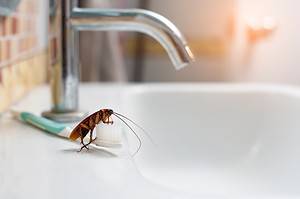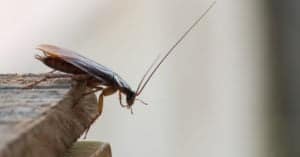The cockroach season in Illinois can be unpredictable, with activity varying from year to year due to climate and migration patterns. During this time, these pests become more active and are likely to be seen in homes and businesses. They’re not only gross but also pose health and environmental risks. These bugs spread illnesses, cause allergies and asthma, and contaminate food and surfaces. Knowing when the cockroach season is in Illinois is essential in preventing and controlling cockroaches. Keep reading to learn more.
When is Cockroach Season in Illinois?
In winter, roach activity in Illinois decreases as many species either hibernate or perish, only to regain momentum once spring and summer bring back the heat. However, this is not the case for states in warmer climates, such as the southern US, where roaches remain active all year round.
For German cockroaches, survival depends on a temperate environment as they cannot withstand the cold. They frequently build nests within the walls of various establishments, including homes, restaurants, supermarkets, and apartments. Their hiding places can range from behind baseboards to drawers, cabinets, and even under appliances like refrigerators and stoves.
American cockroaches primarily dwell outdoors, though they may seek refuge indoors to avoid the scorching heat or the icy chill. Most roaches become vulnerable to the cold when the temperature falls below 50 degrees. This can cause them to invade homes and prosper indoors, much like other pests that hibernate.
The oriental cockroach follows a seasonal developmental pattern. Adult numbers tend to reach their pinnacle during late spring or early summer. However, as summer gives way to fall, this count dwindles significantly, thanks to natural mortality and nymphs’ emergence. Brown-banded cockroaches, present year-round, are also most active in warmer months. They favor drier environments compared to other roach species.

This German cockroach packs a punch when it comes to invading homes and infesting pantries.
©ozgur kerem bulur/Shutterstock.com
Background Information on Cockroaches
A cockroach falls into the order Blattodea, which covers over 4,600 roach species. Its body shape is flat, varying in length from 3 mm to 8 cm, depending on the kind. It has six legs, two antennae, and compound eyes. Some sorts have wings, while not all can fly.
The cockroach’s body consists of the head, thorax, and abdomen. The head holds the mouthparts, adapted for chewing or sucking food. The thorax has legs and wings linked to three pairs of muscular segments. The abdomen houses the digestive, reproductive, and excretory organs.
Roaches have an exoskeleton that protects them from harm and dehydration. It’s made of chitin, the same tough substance as crab and lobster shells. As they grow, they shed the exoskeleton periodically, a process called molting.
The Behavior of a Cockroach
Cockroaches are nocturnal insects that sleep during the day but are active at night. They thrive in dim, damp, and warm environments, such as crevices in walls, floors, furnishings, plumbing, sewers, and waste containers. They also dwell in cellars, lofts, kitchens, and bathrooms, where they can get food and water.
By nature, cockroaches are omnivorous scavengers. They’ll eat virtually anything that they can find. Their diet includes scraps, fat, paper, hair, carcasses of other insects, excrement, and even shed skins. They can eat rotten, dead trees and similar decaying matter due to their ability to digest cellulose.
The communication system of these critters depends on pheromones, chemical messengers that shape their social interactions. They use pheromones to attract mates, demarcate territory, signal threats, or direct foraging expeditions. Their speed rivals only the tiger beetle. At speeds of up to 50 body lengths per second, a roach achieves a sprinter’s pace of 322 kilometers per hour (200 mph). In other words, it could complete a 100-meter dash in under one second!
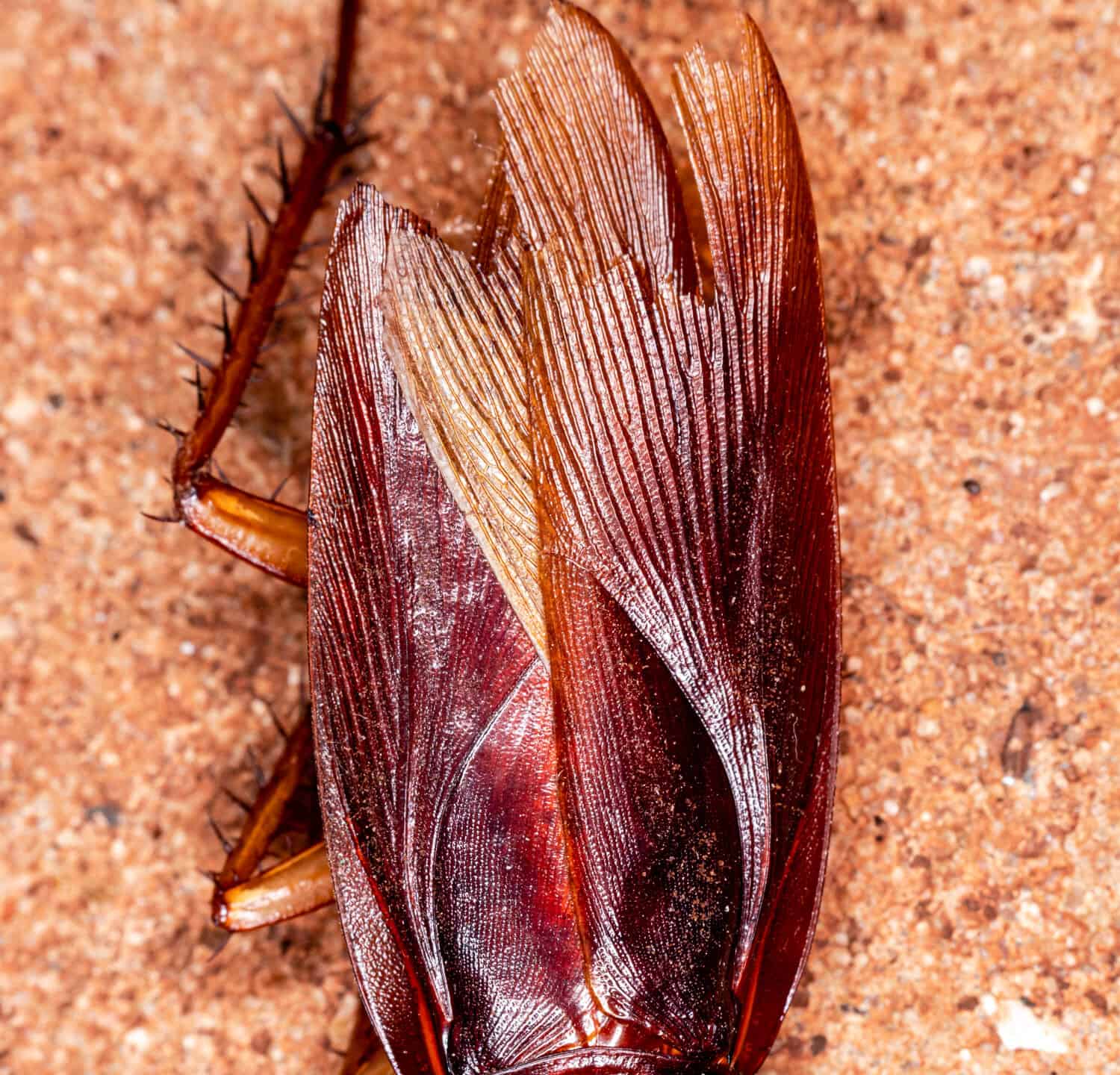
Don’t let their small size fool you – cockroaches are tough survivors!
©Murilo Mazzo/Shutterstock.com
Cockroaches Have a Reputation for Resilience
A cockroach can live without its head for an entire week. They don’t rely on their mouths to breath but instead use minuscule holes in their body to respire. This implies that they can continue breathing even if their head is severed. However, they’ll eventually succumb to dehydration after seven days.
A cockroach can withhold breath for up to 40 minutes and endure complete submersion for a staggering half-hour. Their penchant for conserving breath stems from their intrinsic need to regulate water loss, a survival mechanism they have perfected over time. Therefore, attempts to eliminate them by flushing them down the toilet may prove futile.
Are Cockroaches Dangerous?
Cockroaches can transmit diseases such as cholera and dysentery by crawling over surfaces or food people touch. It is estimated that 63 percent of homes in the United States contain cockroach allergens. The allergens are mainly found in the following:
Cockroach body parts: wings, legs, antennae, or shells that cockroaches shed as they grow and molt.
Cockroach feces: They contain digestive enzymes and proteins that can trigger immune responses in some people.
Cockroach saliva: It contains proteins and enzymes that can cause allergic reactions. Cockroach allergens can cause symptoms such as:
- Sneezing
- Runny nose
- Itchy eyes
- Coughing
- Wheezing
- Shortness of breath
- Chest tightness
- Skin rashes
How To Identify Cockroaches
In Illinois, one can commonly encounter American, German, brown-banded, and oriental cockroaches.
American Cockroaches
Among the pest cockroaches that invade homes and commercial properties, the American cockroach reigns as one of the largest. While equipped with full wings, American cockroaches prefer not to fly, only doing so over short distances. As they have a particular fondness for fermented food, American cockroaches are frequently found in large commercial buildings that store food. Females also frequently glue their egg sacs in cracks and crevices around food.
German Cockroaches
The German cockroach is the most widespread and troublesome cockroach species in Illinois. Their affinity for warmth and humidity leads them to seek refuge in bathrooms and kitchens. In such environments, the German cockroach increases in number quickly, hastening the growth of an infestation. A single female can produce up to five egg sacks, each containing 30-40 eggs, throughout her lifetime. Despite having wings, German cockroaches prefer to scurry rather than take flight. Signs of their presence include droppings and fecal staining in their hideouts. In more extreme cases, one might detect a faint, moldy odor.
Brown-Banded Cockroaches
In the early 1900s, brown-banded cockroaches infiltrated the United States. As their name suggests, they have brown bands across their wings. It’s similar to its German cockroach counterpart but distinguishable by its absence of two dark stripes. They normally seek warm areas where temperatures exceed 80℉. Despite their non-biting nature, they remain dangerous creatures that spread disease-causing bacteria across households and businesses through their legs and bodies. They rely entirely on human-made conditions within homes and buildings for survival, as it doesn’t exist in outdoor habitats.
Brown-banded cockroaches have versatile food habits and consume human food, dyes, starches, stamps, glue, clothing, and books. You can spot them perched high above the ground, seeking refuge in nooks and crannies within cupboards or heat-generating machines. They possess impressive climbing abilities and are active both day and night. Females prefer dark, cozy spaces, such as ceilings, bedding, or tables where they can affix their egg capsules, which bear a yellowish-brown hue.
Notably, due to their natural liking for non-food locales, such as bedrooms and behind furniture, the brown-banded cockroach has earned the nickname “furniture cockroach.” While brown-banded cockroaches are not known for their aggression or propensity to bite, their rapid reproductive rate poses a significant threat to homeowners. A single female brown-banded cockroach can spawn up to 600 offspring in her lifetime, spreading at least 33 distinct bacteria species.

This brown-banded cockroach is the most common household pest.
©Freedom my wing/Shutterstock.com
Oriental Cockroaches
The oriental cockroach, despite its name, is thought to have African roots. It’s a hefty cockroach, often called a “waterbug” because it prefers damp areas. Their sleek, dark frames have earned them the moniker “black beetle cockroaches.” These pests infiltrate homes via crevices below doors and siding. They also use pipes, sewers, and drains for entry.
Despite their large size, adults of each sex have unique physical attributes. The males, growing only up to 25 mm long, have truncated wings that cover only three-quarters of their length. Females, reaching up to 32 mm in length, lack wings altogether, but instead, they feature broad wing pads that cover the initial few segments of their bodies. Despite the physical variations, neither males nor females can fly.
A homeowner’s nose could potentially detect the presence of oriental cockroaches in their home. These cockroaches emit chemical signals, producing a distinctly unpleasant musty scent.
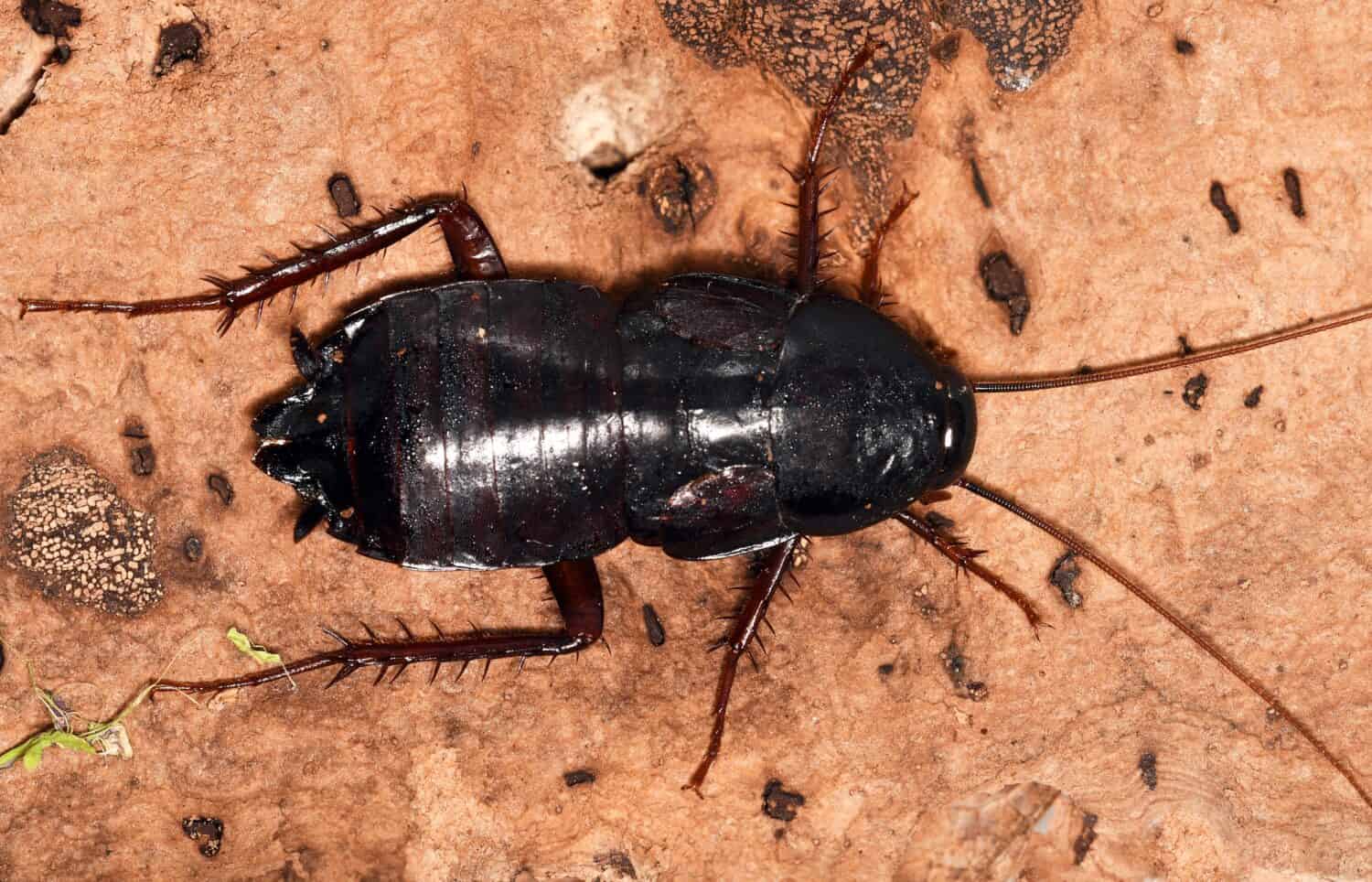
This creepy-crawly is the oriental cockroach, an unwelcome visitor that can infiltrate homes with ease and be a nuisance to live with.
©Guillermo Guerao Serra/Shutterstock.com
How Can You Tell If Your House Is Infested With Cockroaches?
The signs are quite obvious. Droppings and egg cases can be found lurking in cabinets and drawers. Shed skins are also a clear indication of their presence. As they crawl, the unpleasant smell and smear marks left behind are other tell-tale signs. You may even notice damage to cardboard or leather items in your home.
But perhaps the most unmistakable sign of a cockroach infestation is the sight of them scurrying for cover when you turn on the lights. This sudden burst of movement indicates that these pesky insects have made themselves at home in your abode.
How to Eliminate Cockroaches
Eradicating cockroaches can be accomplished in various ways, and some of them are suitable for DIY enthusiasts. In some cases, it may be necessary to employ a combination of tactics to achieve total eradication.
1. Crush Them
Although this approach may appear obvious, stomping on a cockroach as soon as you detect one is advisable. Be warned, these creatures are incredibly resilient and can carry loads 900 times their own weight, so applying significant force and reducing it to fragments is critical.
After squishing the cockroach, sanitize the location and the shoe to minimize the transmission of potentially dangerous diseases or bacteria.
2. Baking Soda
Baking soda has a lethal impact on the roaches. Once they swallow it, gasses gather in their anatomy, leading to their death.
However, using baking soda alone to bait cockroaches might prove futile. The unappetizing flavor repels the insects.
Thus, to lure cockroaches, blend equal portions of baking soda and sugar, and leave the mixture on a plate. Set the trap in an area where cockroaches frequently swarm. Another option is to sprinkle baking soda on onion slices but be cautious, as onions can harm dogs.
3. Peppermint and Citrus Sprays
Despite their pleasant aroma, these scents are detested by roaches and will likely prompt them to vacate (along with their eggs).
If you want to use this method, two options exist. One involves acquiring essential oils, mixing them with water in a spray bottle, and spraying areas prone to roach infestation. Alternatively, you can add a few drops of mint oil or lemon juice to a bucket of water and use the solution to clean countertops and floors.
4. Boric Acid
Boric acid can obliterate roach infestations with ruthless efficiency. Its lethal potency can decimate several roach generations at once.
Formulate dough by combining equal sugar, water, and boric acid portions. Mold this dough into cylinders or balls and deposit them strategically where roaches roam. The initial roaches that feast on the bait will ingest the poison, return to their nest, and die. Subsequent roaches that scavenge on the fallen roaches’ remains and excreta will also meet their demise.
5. Diatomaceous Earth (DE)
Diatomaceous Earth (DE) remains one of the most convenient means to eliminate cockroaches and other pests. The substance consists of fossilized sea organisms whose jagged edges cut insects upon contact, causing them to dehydrate. Despite its potency, DE poses no threat to humans or pets. Dust a fine layer over cockroach-prone surfaces, such as cabinet interiors, basement floors, and underneath appliances.
6. Seek Professional Assistance
Cockroaches reproduce rapidly as their egg cases contain numerous eggs. This can result in substantial infestations. A professional service may be necessary if all attempted methods fail to eliminate cockroaches or if a significant infestation exists.
Preventing Cockroaches: A Simple Guide
The most efficient method is to prevent their entry altogether. Below are some practical tips to prevent cockroaches from infiltrating your home.
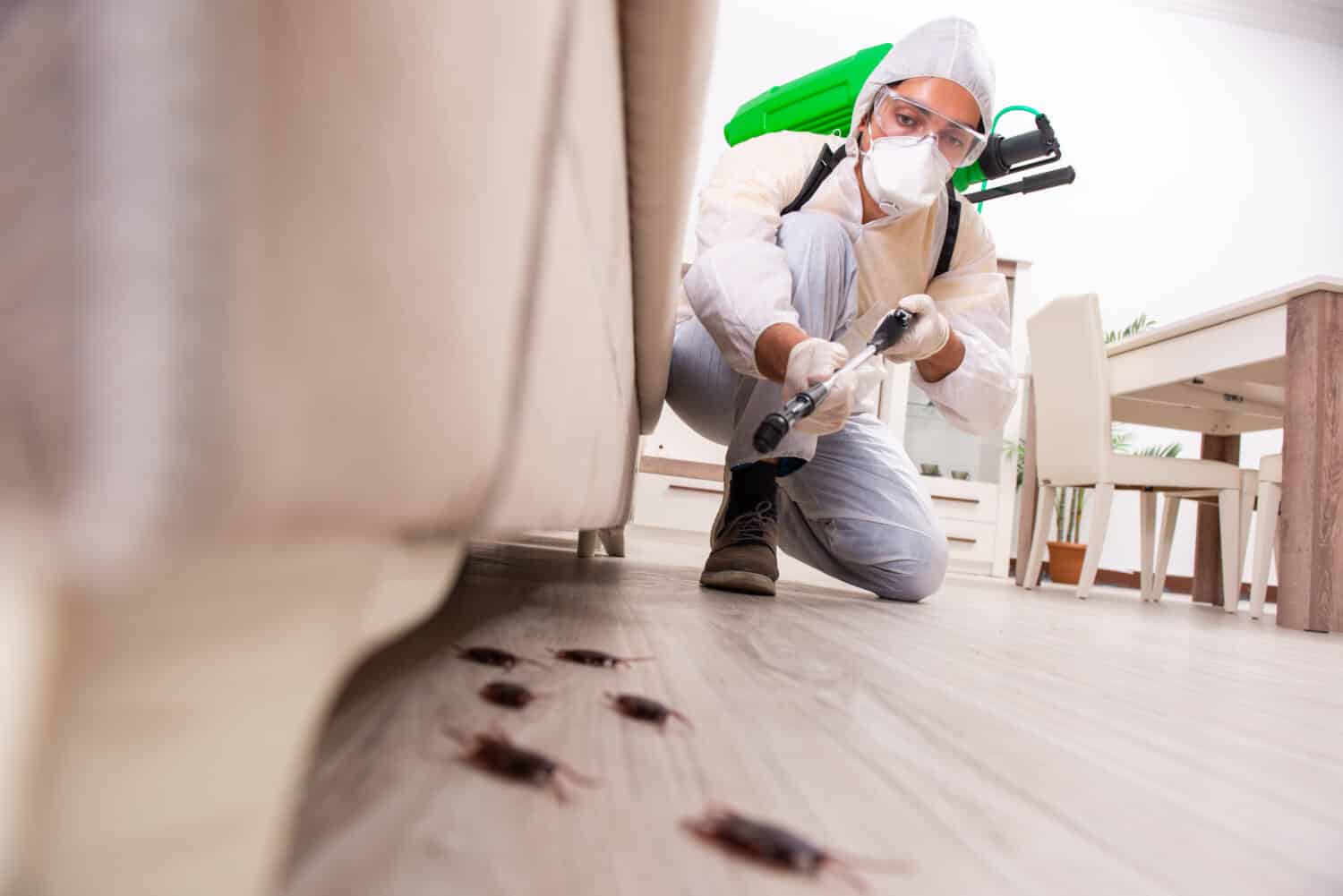
Keep your home clean and free of food debris to help prevent cockroaches from invading.
©Elnur/Shutterstock.com
1. Maintain a Spotless Home
The best strategy to avert cockroaches is to maintain a clean home. These critters can survive on leftovers, crumbs, and other debris. They show up in the dark, indulge in snacks from countertops, floors, or waste bins, and vanish when the light flickers back on.
Ensure you tidy up your kitchen after preparing meals, mop up spills, and dispose of garbage before retiring. Eat in designated areas such as the dining room to minimize the likelihood of food littering other spaces.
2. Eliminate Moisture
Cockroaches thrive in damp environments. Speedily repair any plumbing or roof vents that drip or any other wetness sources that arise. A dehumidifier could be useful if you detect any dampness in the basement
3. Trim Bushes
Numerous cockroach species can use bushes to establish a presence around your abode. Therefore, you should maintain a gap between the house and any shrubs, plants, or lumber stacks that they could use as harborage during warmer months and as entry points during colder seasons.
4. Seal Cracks
Small gaps in the doors, windows, or foundation may seem negligible, but they’re like wide-open doors for cockroaches. When winter comes, cockroaches can use even the tiniest of crevices to infiltrate your home, so seal any gaps.
Surviving Cockroach Season in Illinois
Illinoisans usually lie low during cold and rainy weather. But when summer arrives, roach season takes over, and these creatures swarm in masses. Keeping your kitchen clean, storing food in airtight containers, and regularly disposing of trash are all excellent habits to maintain year-round. However, these measures become even more critical during summer to avoid a potential roach infestation.
The photo featured at the top of this post is © Freedom my wing/Shutterstock.com
Thank you for reading! Have some feedback for us? Contact the AZ Animals editorial team.




